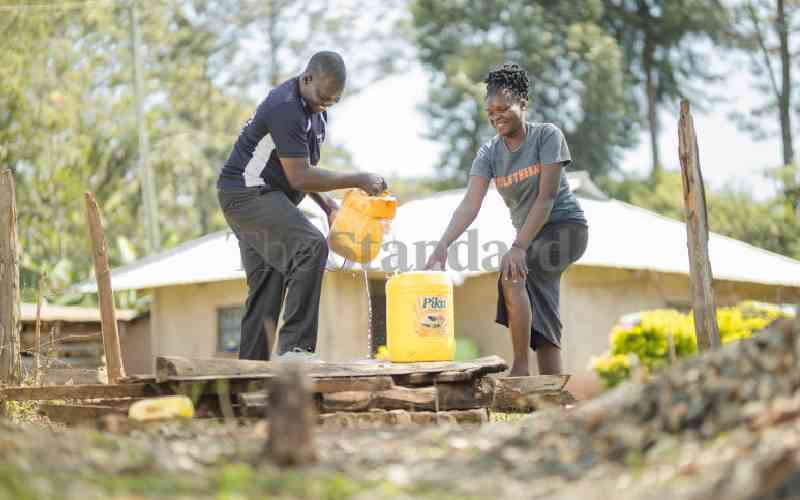
The open plains of Northern Kenya are among the most stunning places in Africa. Scattered acacias jut out of the Earth, breaking free of the parched red Earth that has seen little rain for months. Rocky peaks stand out of the expanse, creating the perfect stage for hiking enthusiasts. With its fame as a wildlife haven, Northern Kenya looks like a little paradise.
But behind this vaunted beauty, it’s haunted by conflict, mainly driven by a lack of enough resources have marred this serene environment. Poor rains have turned the region into a dry landscape where little in the way of food crops grow.
Yet, Northern Kenya is full of stories of resilience.
A couple of weeks ago, I joined a team of scribes on yet another trip to the North. With the midday sun beating down hard on our group, we veer off the Isiolo-Marsabit Road a few kilometres out of Archer’s Post shopping centre into the unknown, driving through the dusty track that leads deeper into the far reaches of Samburu County.
We pass a group of women driving a herd of donkeys laden with domestic goods — beddings, cooking utensils, basins — everything. They seem to be on the move to establish a new settlement in another part of the jungle.
Our first stop was Laresoro village in Kalama Community Conservancy. Like any other Samburu village, Laresoro consists of a cluster of traditional huts woven around a central courtyard. There were only a few children loitering here, some herding goats.
This was a good sign that the community has embraced education by sending them to school. On the other end of the courtyard, Nabiki Lesuper’s shop stands out like a desert rose in a parched land. Two elderly women find the shade of the veranda irresistible.
Lesuper has had no formal education, but is a beacon of hope to her community. One of the group’s stars beaders, her shop was constructed out of the proceeds of a thriving beading industry that incorporates close to a dozen other women here.
On this day, Lesuper’s compound is a beehive of activities. She is a champion and group leader of the local women, and her commitment to seeing her fellow women succeed is evident. She reminisces about the days when she began beading in a nearby manyatta. When hope was all but gone.
The women noticed her determination and followed suit. Today, these women, once at their wit’s end, have turned their small-scale beading industry into a thriving enterprise and, with the support of the Northern Rangelands Trust (NRT), are turning their traditional skills into a viable business model that has seen children go back to school and the community restock after vicious drought cycles decimate their herds.
“The drought has killed our livestock, our principal means of living,” she says. “Beading has come in to fill the void. This was a hobby. It is now serious business. We can pay for our children’s education, have some money for food and water.”
Lesuper and her group are part of 1,300 women who are transforming their communities through the beadwork, earning decent earnings through the local and export market. In the greater region under NRT control, beading artisans earned Sh12 million as labour payment in 2021, a 28 per cent increase compared to Sh9.3 million earned in 2020.
With the sun still high in the sky, we make our way to Lderkesi, another ‘beading’ village near Archer’s Post. Here, the script is the same: women undaunted by the challenges of making a living in some of Kenya’s inhospitable terrain.
Under an acacia tree, their traditional robes flutter in the wind as the beads around their necks glitter in the bright light. Their laughter reverberates across the plains that are hemmed in on one side by the looming Mount Ololokwe.
Beading though is a painstaking task that involves meticulous stitching and passing a thread through the tiny beads with a needle. But the women of Kalama have found a way that helps them go through the rigours of this chore with ease.
They sing — and in Samburu, there is no shortage of good music. In fact, singing is part of any pastoralist community’s life. They sing during birth rites, initiation and marriage ceremonies, and of course when performing any group task.
In Lderkesi, they sang, including one elderly lady sitting towards the back of the pack. She was not beading but her voice carried well over those of her fellow women. Perhaps she no longer beads because her eyesight is not good enough to put the thread in the bead hole.
Or her hands are a bit shaky to pass the thread through the bead holes. But by singing, she contributes to the task by giving moral support to the rest of the team. This is a battle against poverty. In a battle, those who go to war and those who watch over the baggage are valued members of the team.
As we head to our pit stop in Isiolo later in the afternoon, we could not help, but admire the way these resilient women of Kalama are changing the fortunes of their community, one bead at a time.
 The Standard Group Plc is a multi-media organization with investments in media platforms spanning newspaper print
operations, television, radio broadcasting, digital and online services. The Standard Group is recognized as a
leading multi-media house in Kenya with a key influence in matters of national and international interest.
The Standard Group Plc is a multi-media organization with investments in media platforms spanning newspaper print
operations, television, radio broadcasting, digital and online services. The Standard Group is recognized as a
leading multi-media house in Kenya with a key influence in matters of national and international interest.




